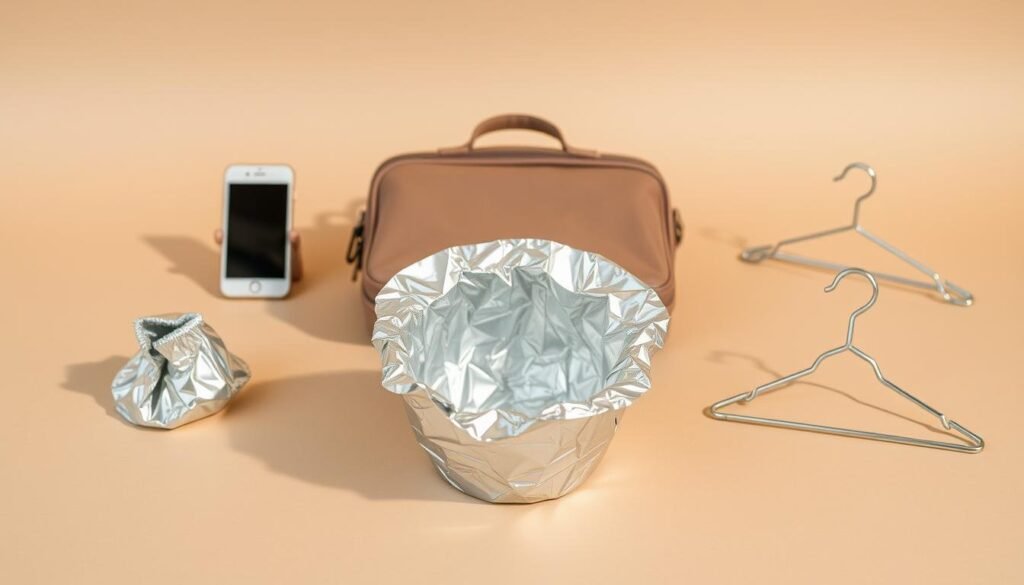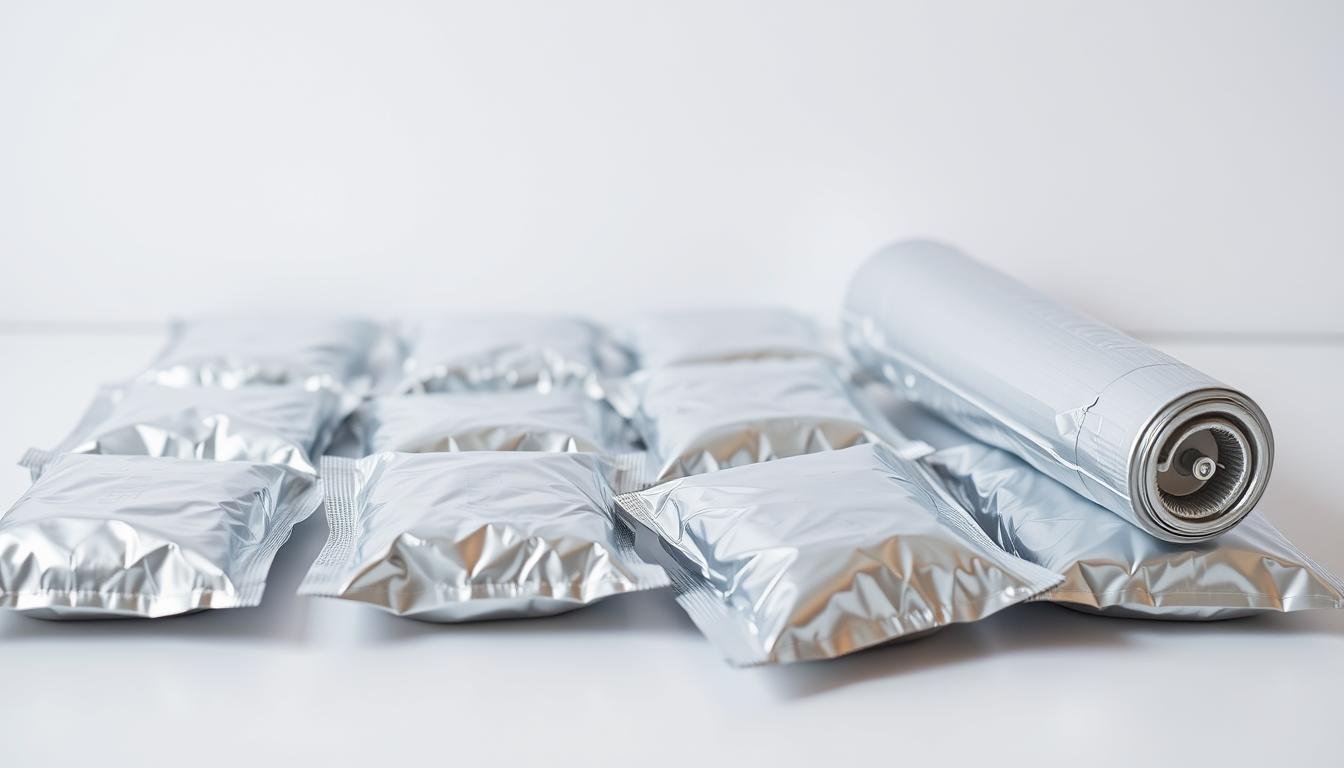Bring Aluminum Foil on a Plane: Traveling can be stressful, especially when packing. You might wonder what’s okay in your carry-on or checked bags. A common question is about aluminum foil.
The Transportation Security Administration (TSA) sets rules for safe travel. They say aluminum foil is okay in both carry-on and checked bags. But, it’s key to know the exact rules to avoid trouble at security checks.
Knowing the TSA’s rules on aluminum foil helps you pack better. Whether you’re wrapping food or protecting fragile items, knowing what’s allowed makes your trip easier.
Contents
- 1 TSA Regulations on Aluminum Foil
- 2 Can You Bring Aluminum Foil on a Plane? The Official Answer
- 3 Carry-On vs. Checked Baggage: Where to Pack Your Foil
- 4 How to Properly Pack Aluminum Foil for Air Travel
- 5 Potential Security Concerns with Aluminum Foil
- 6 Practical Uses for Aluminum Foil While Traveling
- 7 Alternatives to Aluminum Foil for Air Travel
- 8 Conclusion: Bring Aluminum Foil on a Plane
- 9 FAQ
- 9.1 Can I bring aluminum foil on a domestic flight within the United States?
- 9.2 Is aluminum foil allowed in carry-on baggage according to TSA regulations?
- 9.3 Can I pack aluminum foil in my checked luggage?
- 9.4 How should I pack aluminum foil to avoid issues during security screening?
- 9.5 Are there any alternatives to aluminum foil that I can use while traveling?
- 9.6 Can I use aluminum foil for purposes other than packing food while traveling?
- 9.7 Will carrying aluminum foil raise security concerns during my flight?
- 9.8 Can I bring heavy-duty aluminum foil on a plane?
TSA Regulations on Aluminum Foil
The Transportation Security Administration (TSA) has rules for carrying aluminum foil on planes. Knowing these rules helps you pack right and avoid security check problems.
Aluminum foil is okay in both carry-on and checked bags, the TSA says. But, there are things to think about. If you have aluminum foil in your carry-on, you might face extra checks. This is because it’s a dense material that can cause more inspection.
To avoid extra checks, pack your aluminum foil neatly. Make it easy to check by putting it in a clear, resealable bag or a separate bin for X-ray screening.
Here are some key points to remember when carrying aluminum foil:
- Aluminum foil is permitted in carry-on and checked baggage.
- Be prepared for potential additional screening if carrying in carry-on.
- Pack aluminum foil in a way that makes it easy to inspect.
- Consider the quantity and size of the aluminum foil you’re carrying.
Also, remember that while the TSA allows aluminum foil, airlines might have their own rules. Always check with your airline for any specific restrictions before your flight.
By following these guidelines, you can have a smooth security process. And you can enjoy your trip without any aluminum foil issues.
Can You Bring Aluminum Foil on a Plane? The Official Answer
Are you thinking about bringing aluminum foil on a plane? It’s key to know the TSA’s rules. The Transportation Security Administration (TSA) has clear guidelines on what you can bring on flights.
The TSA says you can bring aluminum foil in both carry-on and checked luggage. But, be ready for extra checks if you have a lot or if it’s wrapped around other things.
When packing aluminum foil for air travel, think about how it’s shaped. Sheets of foil are usually okay, but if it’s wrapped around something odd or crumpled, security might take a closer look.
To stay safe, put aluminum foil in a clear, sealed plastic bag if it’s in your carry-on. This makes security checks easier.
Carry-On vs. Checked Baggage: Where to Pack Your Foil
When packing for your flight, you might think about where to put your aluminum foil. It depends on your travel needs, how much foil you have, and your safety concerns.
Safety and Security
The Transportation Security Administration (TSA) has rules to guide you. Aluminum foil is okay in both carry-on and checked bags, but there are things to remember.
In carry-on bags, make sure your foil doesn’t cause any issues at security. Put it in a clear, quart-sized zip-top bag or wrap it around other items so it doesn’t look like something you shouldn’t have.
| Considerations | Carry-On Baggage | Checked Baggage |
|---|---|---|
| Security Screening | May require additional screening if not properly packaged | Not subject to the same security screening as carry-on |
| Accessibility | Easily accessible during the flight | Not accessible during the flight |
| Quantity Limits | No specific limits, but excessive quantities may raise questions | No specific limits |
In checked bags, the main thing is to pack your foil well to avoid damaging other items. Wrap things tightly or use a protective cover.
Choosing between carry-on and checked baggage for your foil depends on your needs. Carry-on is good if you need it during the flight. But if you have a lot or worry about security, checked might be better.
How to Properly Pack Aluminum Foil for Air Travel
Packing aluminum foil for a flight needs some planning. You must avoid damage and security issues. Think about how to wrap, store, and protect it.
Begin by keeping the foil in its original packaging or roll. If that’s not possible, wrap it around a sturdy object like a cardboard tube. This prevents it from unfolding or getting crumpled.
For storing aluminum foil in your luggage, follow these tips:
- Wrap the foil in a plastic bag or a ziplock bag to prevent damage or mess.
- Keep it away from sharp objects or other items that could puncture or tear it.
- If checking luggage, wrap the foil in clothing or soft items for extra cushioning.
Here are more tips for using aluminum foil while traveling:
| Use | Benefit |
|---|---|
| Wrapping snacks | Keeps food fresh and prevents spills |
| Covering toiletries | Prevents leakage and keeps items clean |
| Protecting electronics | Provides a layer of protection against static electricity and moisture |
By following these tips, your aluminum foil will arrive safely. It’s great for keeping snacks fresh or protecting your belongings. Aluminum foil is a versatile and useful item for travel.
To make your trip better, think about the uses for aluminum foil while traveling. It can be a makeshift container for liquids or a plate for eating.
Potential Security Concerns with Aluminum Foil
When you’re getting ready for your flight, you might think about aluminum foil. It’s a metal, so it might cause extra security checks. This is because it could hide banned items or mess with security scanners.
Knowing the TSA rules on aluminum foil is key. The TSA says you can bring it in both carry-on and checked bags. But, you must pack it right to avoid problems.
To avoid security worries, follow these tips:
- Store your aluminum foil in its original packaging or a clear, resealable bag for easy screening.
- Don’t wrap suspicious or banned items in aluminum foil.
- Be ready to take out the aluminum foil from your carry-on for X-ray screening if asked by security.
Knowing how aluminum foil is handled at security checks can help you get ready. Here’s a quick guide:
| Item | Allowed in Carry-On | Allowed in Checked Baggage | Special Instructions |
|---|---|---|---|
| Aluminum Foil | Yes | Yes | Pack in original packaging or clear, resealable plastic bag |
| Aluminum Foil Wrapping Items | No, if wrapping prohibited items | No, if wrapping prohibited items | Avoid wrapping suspicious or prohibited items |
Being careful with how you pack and use aluminum foil can help avoid security problems. If you’re unsure about something, always check with the TSA or your airline for the latest advice.
Practical Uses for Aluminum Foil While Traveling
Aluminum foil is more than just for wrapping leftovers. It’s a handy travel companion. Whether you’re going on a short weekend getaway or a longer international trip, aluminum foil can be very useful.
One common use for aluminum foil while traveling is for packing snacks. You can wrap sandwiches, fruits, or leftovers in foil. This keeps them fresh and makes them easy to carry. It’s great on long flights or road trips where healthy snacks might be hard to find.

Aluminum foil can also be used in other creative ways. For example, you can:
- Protect fragile items in your luggage by wrapping them in foil.
- Create a makeshift container for carrying small items or leftovers.
- Keep your clothes clean by wrapping messy or dirty items in foil.
Here’s a comparison of different uses for aluminum foil while traveling:
| Use | Benefit | Tip |
|---|---|---|
| Packing Snacks | Keeps food fresh, easy to carry | Use heavy-duty foil for better durability |
| Protecting Fragile Items | Prevents breakage, adds extra cushioning | Wrap items tightly to prevent movement |
| Makeshift Container | Convenient, reduces waste | Clean and dry the foil before use |
As you can see, aluminum foil is a versatile item that makes traveling more convenient. By adding it to your packing list, you can enjoy a more organized and stress-free journey.
Alternatives to Aluminum Foil for Air Travel
If you’re worried about bringing aluminum foil on a plane, don’t fret. There are many other options for your travel needs. You can pack snacks, keep things fresh, or protect your items with different materials.
Beeswax wraps are a great alternative to aluminum foil. They’re perfect for covering snacks or keeping items fresh. Plus, they’re eco-friendly and can be used many times, making them ideal for travelers who want to reduce waste.
For packing food or other items, consider using plastic containers or zip-top bags. They’re not as green as beeswax wraps but work well to keep things fresh. They’re also okay in both carry-on and checked baggage.
If you need to protect fragile items, think about using bubble wrap or packing paper. These materials offer the right cushioning to keep your items safe while traveling.
By trying out these alternatives, you can have a hassle-free trip without aluminum foil.
Conclusion: Bring Aluminum Foil on a Plane
Now you know the TSA rules on aluminum foil. You can pack it in your carry-on or checked luggage. It’s important to know what you can bring on a plane to avoid security issues.
The TSA allows aluminum foil in both carry-on and checked luggage. But, it’s best to pack it right to avoid security worries. You can use it to wrap snacks or cover dishes. If you’re worried, you can use plastic wrap or reusable containers instead.
Knowing the TSA rules on aluminum foil makes traveling easier. Whether you’re packing a picnic or storing leftovers, knowing what you can bring makes your trip smoother.
See Also: Can You Bring Alkaline Batteries on a Plane?
FAQ
Can I bring aluminum foil on a domestic flight within the United States?
Yes, you can bring aluminum foil on a domestic flight. Just check with your airline for any specific rules.
Is aluminum foil allowed in carry-on baggage according to TSA regulations?
Yes, you can have aluminum foil in your carry-on. But, it might get extra screening if it sets off alarms.
Can I pack aluminum foil in my checked luggage?
Yes, you can pack aluminum foil in your checked luggage. There are no big restrictions on it in checked bags.
How should I pack aluminum foil to avoid issues during security screening?
To avoid problems, put aluminum foil in a clear, resealable plastic bag. Wrap it around a cardboard core or other non-metal item to lower alarm chances.
Are there any alternatives to aluminum foil that I can use while traveling?
Yes, you can use parchment paper, wax paper, or reusable containers instead. They work well for packing snacks or other items.
Can I use aluminum foil for purposes other than packing food while traveling?
Yes, aluminum foil is useful for other things too. You can use it to wrap souvenirs, protect electronics, or even as a makeshift utensil or plate.
Will carrying aluminum foil raise security concerns during my flight?
Carrying aluminum foil might cause security worries if not packed right or if it sets off alarms. But, following TSA rules keeps the risk low.
Can I bring heavy-duty aluminum foil on a plane?
Yes, you can bring heavy-duty aluminum foil on a plane. Just remember to follow the same TSA guidelines and packing tips as for regular foil.

Hello, I’m Janiyah Gibbs—a retired flight crew member and former TSA officer from Alaska, USA. At PlaneCarry.com, I share expert insights on what to carry (and avoid) when flying.

